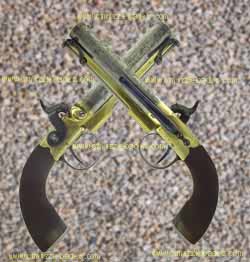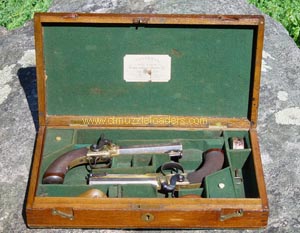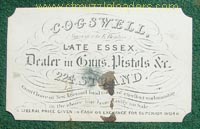The pair shown here were manufactured by Benjamin Cogswell. According to Nigel Brown, he maintained a business at 224 Strand from 1857 to 1863; which thereafter became the well-known firm of Cogswell and Harrison. This pair of .53 caliber, brass-frame percussion boxlock pistols were a slim and elegant accompanyment to a gentleman's dress. They are perhaps slightly anachronistic in that they are large-bore, single shot pistols at a time when multiple-shot pistols and revolvers were coming into fashion, but the large bore would certainly have been very effective, and their slim profile would make them very easy to carry. I don't know how they would have actually been carried. Their profile is that of a boot-pistol, which were tucked into or carried in a holster inside of a boot, but their side hook suggests they may have been carried on a belt, sash or inside pocket. In either case, they would have come quickly to hand if the need arose.
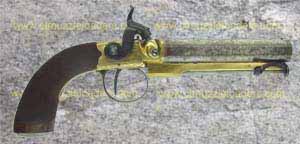

The pistols are of fine but not overly elaborate quality, with a cast-brass boxlock and .53 caliber barrel with a case-hardened finish. The steel ramrod is the 'captive' type most usually found on military pieces, but the absence of a stock almost mandates this type of arrangement here. The barrel, frame and furniture all have some engraving, and the diminutive stock is almost completely covered by very fine, well-executed checkering, which gives a surprisingly good grip for such a tiny stock.
The Anatomy of a Boxlock
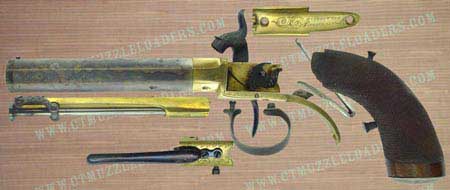 A boxlock is one in which the internal mechanism of the lock is contained within the
frame of the gun. In this example, the frame, bolster and powder chamber are cast as a single piece of brass
onto which the barrel is screwed. The side-plate (to which the hook is attached) fastens to the frame with a
forward-located pin (not visible here) and a screw. A partially-drilled hole in this plate serves as a bearing
for the minor tumbler axle and acts like the bridle on a traditional lock. The removable top plate covers the
remainder of the frame and provides a second attachment point for the wooden grip (and also has a rudimentary
rear sight). The main spring attaches to the frame by a simple hook arrangement, and a stirrup connects the
tip of the spring to the rear of the tumbler. The trigger is pinned into the frame, with the trigger return
spring held in place with a simple pin. The captive ramrod is in a self-contained cast brass holder which
screws into the barrel. One interesting thing was that the screws go completely through the barrel wall, as
does the front sight! When properly cast, this is a simple mechanism to finish and assemble, and it makes for
a very rugged lock. Since the inside of the gun was never seen by the owner, it was unfinished except for the
necessary bearing surfaces. This contrasts with the detachable locks whose insides were often as well-finished
as the outside.
A boxlock is one in which the internal mechanism of the lock is contained within the
frame of the gun. In this example, the frame, bolster and powder chamber are cast as a single piece of brass
onto which the barrel is screwed. The side-plate (to which the hook is attached) fastens to the frame with a
forward-located pin (not visible here) and a screw. A partially-drilled hole in this plate serves as a bearing
for the minor tumbler axle and acts like the bridle on a traditional lock. The removable top plate covers the
remainder of the frame and provides a second attachment point for the wooden grip (and also has a rudimentary
rear sight). The main spring attaches to the frame by a simple hook arrangement, and a stirrup connects the
tip of the spring to the rear of the tumbler. The trigger is pinned into the frame, with the trigger return
spring held in place with a simple pin. The captive ramrod is in a self-contained cast brass holder which
screws into the barrel. One interesting thing was that the screws go completely through the barrel wall, as
does the front sight! When properly cast, this is a simple mechanism to finish and assemble, and it makes for
a very rugged lock. Since the inside of the gun was never seen by the owner, it was unfinished except for the
necessary bearing surfaces. This contrasts with the detachable locks whose insides were often as well-finished
as the outside.
Furniture and Finish
 Since this was a Gentleman's Gun, it has a
higher degree of finish and embellishment than would be seen in an ordinary weapon. All parts have at least
some simple but well-executed engraving, and the overall fit and finish is of very good quality.
Since this was a Gentleman's Gun, it has a
higher degree of finish and embellishment than would be seen in an ordinary weapon. All parts have at least
some simple but well-executed engraving, and the overall fit and finish is of very good quality.



 The buttcap is also nicely engraved with a case-hardened finish, and in the center of the
buttcap is a lid which flips open to reveal a small cavity for cap storage. The barrel shows a London
definitive black powder proof mark, and the brass frame bears a London view mark.
The buttcap is also nicely engraved with a case-hardened finish, and in the center of the
buttcap is a lid which flips open to reveal a small cavity for cap storage. The barrel shows a London
definitive black powder proof mark, and the brass frame bears a London view mark.
It's Pretty, But Is It Effective?
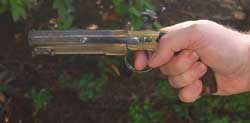 The large bore and 3 1/2 inch barrel would
certainly suggest so, but with its light weight (16 oz.) and small grip, could it be effectively handled with
a decent powder charge? To find out, the pistol was loaded with a bare ball of .53 caliber (223 gr), which fit
the barrel just snugly enough to stay in place. It was fired with a range of powder charges at "assailant
range" - about 15 feet.
The large bore and 3 1/2 inch barrel would
certainly suggest so, but with its light weight (16 oz.) and small grip, could it be effectively handled with
a decent powder charge? To find out, the pistol was loaded with a bare ball of .53 caliber (223 gr), which fit
the barrel just snugly enough to stay in place. It was fired with a range of powder charges at "assailant
range" - about 15 feet.
| Load | 15 Grains Swiss 2F | 20 Grains Swiss 2F | 25 Grains Swiss 2F |
| Ave. Velocity | 327 | 370 | 415 |
| Energy (fpe) | 53 | 68.2 | 85 |
With a 25 grain load, the pistol bucked a lot and the ramrod would come loose after the shot, but I could place all shots in a pieplate at that distance with all loads. This would clearly discourage a footpad!
